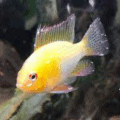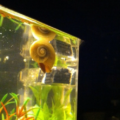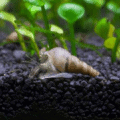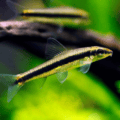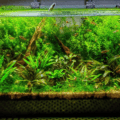Betta fish, renowned for their vibrant colors and distinctive fin displays, are often considered an ideal choice for low-maintenance pets. From tank setup and nutrition to water quality maintenance, this comprehensive guide shines a light on the question, revealing the answer to if keeping a Betta Alive is easy.

Introduction
When it comes to low-maintenance pet options, betta fish are often at the top of the list. These beautiful, vibrant fish are known for their long, flowing fins and vivid colors.
A Betta’s fins tell a unique story with each fin acting like a canvas splashed with color. However, are betta fish really as easy to keep alive as they are often claimed to be?
Understanding the Basics of Betta Fish Tank Care
Before diving into the question of their ease of care, let’s first explore the basics of betta fish care. Betta fish, also known as Siamese fighting fish, are tropical fish native to the rice paddies of Southeast Asia including countries such as Thailand, Cambodia, Laos, and Vietnam.
They have unique characteristics that make them different from other fish species, the most loved of which are their vibrant colors, while the most difficult of which are their aggression which does not always make them the best community fish.
Typically grow to around 2.5 to 3 inches in length, with some reaching up to 3.5 inches in ideal conditions
Betta fish live on average 2 – 5 years, but your Betta’s life span largely depends on its environment. Creating the perfect natural habitat is crucial for the health and well-being of a betta fish.
Start by choosing the right sized tank – at a minimum a 5-gallon tank is recommended to provide ample space for your Betta fish to swim and explore, smaller tanks are not recommended even though Betta often are kept in these smaller tanks while in the fish store.
Ideally, a 10-gallon tank scaped with live plants and plenty of hiding places would make your betta’s tank a much more natural fish tank. Artificial plants can also work but keep in mind we are trying to recreate the tropical environment your Betta fish would be most comfortable with in their fish tank.

So a planted tank consisting of plants such as Java Fern (Microsorum pteropus), Anubias (Anubias spp.), Amazon Sword (Echinodorus spp.), and Java Moss (Taxiphyllum barbieri) would be great. No matter how you decide to set up your Betta’s tank, again I repeat it is not acceptable to keep your Betta fish in the same or similar fish tank as those in the pet store.
A larger tank instead of the 1-gallon tank and sometimes even smaller tanks without filter media are an easy way to end up with an infected fish living a less-than-quality life.
Speaking of water conditions, it is essential to monitor and maintain a healthy range of your water’s pH levels and temperature. Essential equipment to do this includes suitable filter media and a heater to maintain optimal water conditions.
Betta fish thrive in warm dechlorinated water between 78-80°F (25-27°C) with their water’s pH range between 6.5-7.5. Be sure to change your aquarium’s water regularly as this is important to prevent the buildup of harmful toxins and maintain good water quality.
| Characteristics | Details | |
| Scientific name | Betta splendens, commonly known as Siamese fighting fish | |
| Origin | Native to the rice paddies of Southeast Asia | |
| Temperature | between 78-80°F (25-27°C | |
| PH | pH range between 6.5-7.5 | |
| Life span | Betta fish have an average lifespan of 2 to 5 years | |
| Tankmates | neon tetras, Corydoras catfish, or snails | |
| Color and marking | Known for their vibrant and diverse coloration, including shades of red, blue, green, purple, and white, with various fin types and patterns. | |
| Size | 2.5 – 3.5 inches | |
Easy Betta Fish Care Tips for Beginners
As a beginner, taking care of betta fish can seem complex, but a few simple tips can ensure the well-being of your finned friend:
1. Establish a Consistent Routine: Maintain a regular schedule for feeding, water changes, and tank maintenance.
2. Observe Behavioral Cues: Pay attention to your betta fish’s behavior and appearance. Any sudden changes could indicate a problem.
3. Handle Stress Factors: Avoid overcrowding the tank, provide hiding places, and minimize exposure to loud noises to reduce stress levels.
4. Prevent Common Diseases: Be vigilant about identifying symptoms of illness, quarantine sick fish, and maintain good hygiene practices to prevent the spread of disease.
Nutrition – Betta Fish Food
Feeding your betta fish the right food is crucial for their overall health and vitality. Betta fish are carnivorous and require a protein-rich diet.
Choose high-quality betta fish pellets or flakes that are specifically formulated for their nutritional needs. Supplement their diet with occasional treats like freeze-dried bloodworms or brine shrimp for added variety.
When it comes to feeding frequency and portion control, it’s important to strike the right balance. A happy Betta fish is not a fat one.
Overfeeding can lead to obesity and other health issues, while underfeeding can result in malnutrition. Feed your betta fish small portions twice a day and monitor their eating habits to ensure they are consuming an adequate amount.

Here are some tips when feeding your Betta:
- Remove Excess Betta Food: Use a fish net or siphon to remove any uneaten food from the water’s surface and substrate shortly after feeding. Leaving food in the aquarium can lead to water pollution and deteriorate tank water quality.
- Monitor Feeding Amounts: Be mindful of the amount of food you offer your Betta fish during each feeding session. Overfeeding can lead to excess waste buildup and negatively impact aquarium water parameters. Only provide as much food as your Betta fish can consume within a few minutes.
- Opt for High-Quality Food: Choose high-quality Betta fish food that is specifically formulated for Betta fish and their dietary needs. High-quality food is more digestible and less likely to contribute to waste buildup in the aquarium.
- Feed Sparingly: Rather than offering large meals infrequently, consider feeding your Betta fish small portions multiple times a day. This approach can help prevent overfeeding and reduce the amount of uneaten food accumulating in the tank.
- Consider Feeding Alternatives: In addition to traditional fish pellets or flakes, consider offering your Betta fish a variety of nutritious frozen foods and live foods like bloodworms, brine shrimp, or daphnia. These alternatives are often more appealing to Betta fish and less likely to go uneaten.
- Utilize Feeding Rings or Stations: To prevent food from scattering across the aquarium and sinking into the substrate, consider using feeding rings or stations. These devices help contain the food in one area of the tank, making it easier for fish to locate and consume.
Maintaining Water Quality
Betta fish need a clean and well-maintained cycled tank for their longevity. Regular water changes are necessary to remove any accumulated waste and toxins.
Aim for a 20-30% water change every week, making sure to use a water conditioner for creating safe dechlorinated water if using tap water in your Betta fish tank. Also be sure to use an aquarium test kit to frequently test water parameters to ensure water parameters are kept within acceptable ranges.
In addition to regular water changes, maintaining the right water temperature and employing appropriate filtration systems and oxygenation systems is essential to keep your Betta happy. Using a sponge filter or an air stone and separate filter can both filter the water and aerate it!
Betta fish need clean, oxygen-rich fresh water to thrive, so investing in a suitable filter and ensuring proper oxygenation is crucial for a healthy life span. Be sure to use an aquarium thermometer to ensure your betta’s tank stays between 78-80°F (25-27°C), being tropical fish, Betta prefer warm water as previously mentioned.
Handling and Tank Mates

While Betta fish are relatively hardy, they should be housed alone or with peaceful tank mates if in a community tank. Avoid keeping multiple male Betta fish in the same tank, as they are prone to aggression and territorial behavior.
Compatible tankmates for Betta fish include small, peaceful species such as neon tetras, Corydoras catfish, or snails. Introduce other fish gradually and monitor their interactions closely to ensure compatibility.
Handling Betta Fish:
- Use a gentle approach: When handling Betta fish, always use a gentle touch and avoid sudden movements. Net them carefully if necessary, ensuring the safety of their delicate fins.
- Avoid excessive handling: Betta fish can become stressed if handled too frequently, so it’s best to minimize handling to essential maintenance tasks such as tank cleaning or health checks.
Healthcare and Disease Prevention
Preventing diseases is crucial for maintaining Betta fish health. Quarantine new fish before introducing them to the main tank to prevent the spread of diseases. Keep the aquarium clean, provide a balanced diet, and maintain stable water parameters to boost their immune system.
Common Betta fish diseases include fin rot, ich, and fungal infections, so familiarize yourself with the symptoms and seek treatment promptly if needed. Avoid overcrowding the tank, as it can stress the fish and weaken their immune system.
Breeding & Taking Care of Baby Betta Fish

Breeding Betta fish can be a rewarding yet challenging endeavor that requires careful planning, preparation, and patience.
- Selecting Breeding Pair:
- Choose healthy, mature bettas with vibrant colors and finnage.
- Avoid fish with deformities or genetic issues.
- Select a male (betta splendens) and a female (betta splendens) with desirable traits such as long fins, bright colors, and active behavior.
- Conditioning:
- Before breeding, condition the breeding pair with a high-protein diet including live or frozen foods such as bloodworms, brine shrimp, and daphnia.
- Maintain optimal water conditions with regular water changes and proper filtration.
- Keep the temperature between 78-82°F (25-28°C) and maintain stable water parameters (pH 6.5-7.5, hardness 5-20 dGH).
- Introducing the Pair:
- Place the male and female bettas in separate tanks adjacent to each other to allow visual contact and acclimation.
- Introduce the pair in a breeding tank divided by a transparent divider to prevent aggression while allowing visual interaction.
- Courtship:
- Monitor the pair for signs of courtship, including flaring, fin displays, and nest building by the male.
- Once the male has built a bubble nest at the water’s surface, and the female displays vertical stripes (indicating readiness to spawn), carefully remove the divider to allow breeding.
- Spawning:
- During spawning, the male will embrace the female and wrap his body around her, releasing sperm (milt) as the female releases eggs (oviposition).
- The eggs are fertilized as they fall into the bubble nest, where the male collects and places them.
- After spawning, remove the female to prevent aggression from the male.
- Egg Care:
- The male betta will tend to the bubble nest, guarding the eggs and ensuring they remain in the nest.
- Maintain optimal water conditions and provide gentle aeration to prevent stagnant water around the nest.
- Remove any unfertilized or fungus-covered eggs to prevent contamination.
- Fry Care:
- Betta fry will hatch within 24-48 hours and remain in the bubble nest until they become free-swimming (3-5 days post-hatch).
- Once free-swimming, separate the fry from the male to prevent predation.
- Feed the fry with infusoria, micro-worms, or commercial fry food multiple times a day.
- Perform regular water changes to maintain water quality and prevent disease.
- Growth and Development:
- As the fry grow, gradually introduce larger food items such as newly hatched brine shrimp or finely crushed flakes.
- Provide ample space and hiding spots for the growing fry to reduce aggression and stress.
- Monitor tank parameters closely and maintain optimal conditions to promote healthy growth and development.
- Separation and Culling:
- As the fry grow, separate and cull them based on desirable traits such as color, finnage, and body shape.
- Transfer selected baby bettas to individual grow-out tanks for further development and maturation.
- Patience and Persistence:
- Breeding bettas requires dedication, patience, and a willingness to learn from both successes and failures.
- Experiment with different breeding pairs, techniques, and strategies to improve your breeding outcomes over time.
Remember to prioritize the well-being of your fish and provide them with the care and attention they need throughout the breeding process.
Common Misconceptions and Myths about Betta Fish Care

Now let’s address some common misconceptions and myths surrounding betta fish care:
Myth: Betta Fish Can Survive in Small Containers
Contrary to popular belief, betta fish require a minimum tank size of 5 gallons to ensure adequate space and water quality.
Myth: Betta Fish Don’t Need an Aquarium Filter or Heater
While betta fish are hardy, they still require an aquarium filter for proper filtration and oxygenation and an aquarium heater to maintain the ideal water temperature.
Myth: Betta Fish Can Thrive on a Diet of Flakes Alone
While betta fish can survive on flakes, betta fish need a varied diet that includes protein-rich pellets and occasional treats which is essential for their overall health.
Myth: Betta Fish Can Live in Community Tanks
Betta fish are known for their aggressive nature and territorial behavior, making them unsuitable to live in a community tank. They are best kept alone to prevent conflicts.
Conclusion
While betta fish are generally considered low-maintenance, providing them with the right habitat, nutrition, and care is crucial for their health, longevity, and most importantly making your Betta happy.
By understanding their needs and taking proactive measures, betta fish are indeed relatively easy to keep alive and can be a delightful addition to any home aquarium.



